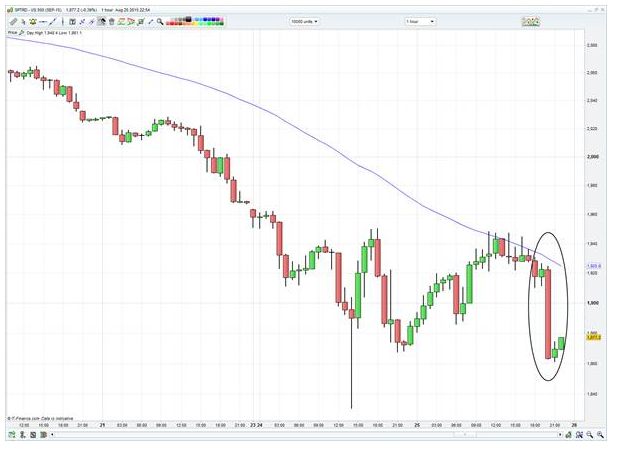No Crisis; Volatility In Control
IG | Aug 26, 2015 02:13AM ET
Bottom or top – where do you look?
I cannot remember a 48 hours of trade like we’ve seen in the first two days of this week – and I mean ever.
2008, 2011 and 2012 were more volatile and had longer declines and rises, but never a 4.1% down day then immediately followed up with a 2.7% gain.
Monday and Tuesday paint a very interesting trading picture: to follow fundamentals or macro sentiment?
Bottom up view
Asian indices have stock fundamentals that are near some of the cheapest levels they have been in the past four years:
The ASX is trading on a trailing P/E of 14.7 times the cheapest level since mid-2012 and a dividend yield of 5.2%
The Nikkei is at 18.6 times trailing P/E, – a 52 week low and a yield of 1.7%
Hang Seng is at 9.2 times trailing P/E – lowest level since March 2012 with a yield of 3.9%
Strait Times Index is at 12.98 times trailing P/E – also a 52-week low and a yield of 3.98%
Getting stock specific, BHP (NYSE:BHP) now has the larger discount to net present value in a post GFC world. Although the earnings numbers after market yesterday were mixed-to-slightly-weak, the discount does appear overdone.
Valuation fundamentals are making very strong buy cases. The price reaction in the Australian banks yesterday clearly tells you that there is strong fundamental support from bottom up views.
Top down views
As predicted, the PBoC has gone down the ECB/Fed route of doing ‘whatever it takes’ to support their economy. Last night, the PBoC cut benchmark interest rates by 25 basis points (deposit and lending) and cut the reverse requirement ratio (RRR) by 50 basis points to 17.5%. Estimates vary, but it’s believed the cut to the RRR will inject around RMB600 to RMB700 billion into the economy. Will this be enough?
Asia remains the epicentre of the current market instability, as fears of emerging market (EM) growth and currency run-ons invoke memories of the 1997/1998 Asian financial crisis. The difference here is that country fundamentals are much stronger, currency reserves are bigger than the mid-1990s, and as are balance sheets.
Market ‘stability’ will then come from this region – however, the slide in China and Japan suggests sentiment is ruling price action and hyper-fear trading is still in control.
The slide in China is even more interesting, as it’s not about the collapse in the equity markets and the possible ‘flow-on’ effect to the economy. In actuality, the connection between the Chinese equity market and the Chinese economy is very limited. It’s the fact that there is now a perception of ‘loss of control’ and a ‘loss of face’ for the central government.
The US markets strike me as the biggest dilemma for global trade. Plenty are blaming EM growth fears and global deflation for US trade; however, I see it differently. This feels like ‘taper tantrum’ in 2013, and ‘hike hysteria’ is clearly the other factor pushing on US trader. Volatile trade is only going to get stronger as each FOMC meeting approaches.
Secondly, implied volatility is going to move markets like we saw in the final two hours of US trade. Not one single piece of news explains this downward move, and with the VIX at 40, moves like the final hour will happen regularly in the short term.

S&P hourly chart showing the final hour of US trade
Conclusion
I can make clear arguments for buying this market, and I can similarly make a compelling case to sell it.
Yesterday’s bounce was a clear sign that panic selling was the driving force for ‘Black Monday’ and the fundamentals were too strong to ignore. But macro themes are not pointing to a crisis but to whip trading. Volatility is in control and this will create events similar to the final hour in the US markets.
Ahead of the open, we are calling the ASX down three points to 5134. However, with the Aussie VIX at 31, we too are exposed to massive swings.
Trading in financial instruments and/or cryptocurrencies involves high risks including the risk of losing some, or all, of your investment amount, and may not be suitable for all investors. Prices of cryptocurrencies are extremely volatile and may be affected by external factors such as financial, regulatory or political events. Trading on margin increases the financial risks.
Before deciding to trade in financial instrument or cryptocurrencies you should be fully informed of the risks and costs associated with trading the financial markets, carefully consider your investment objectives, level of experience, and risk appetite, and seek professional advice where needed.
Fusion Media would like to remind you that the data contained in this website is not necessarily real-time nor accurate. The data and prices on the website are not necessarily provided by any market or exchange, but may be provided by market makers, and so prices may not be accurate and may differ from the actual price at any given market, meaning prices are indicative and not appropriate for trading purposes. Fusion Media and any provider of the data contained in this website will not accept liability for any loss or damage as a result of your trading, or your reliance on the information contained within this website.
It is prohibited to use, store, reproduce, display, modify, transmit or distribute the data contained in this website without the explicit prior written permission of Fusion Media and/or the data provider. All intellectual property rights are reserved by the providers and/or the exchange providing the data contained in this website.
Fusion Media may be compensated by the advertisers that appear on the website, based on your interaction with the advertisements or advertisers.